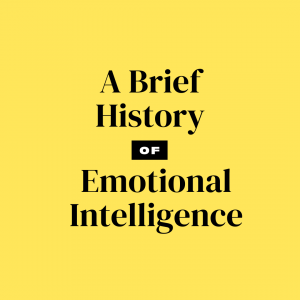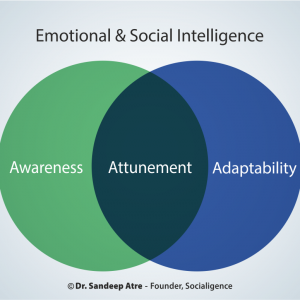
In the early days of Emotional Intelligence, The Harvard Business Review hailed it as one of the most influential business ideas that is “ground-breaking and paradigm-shattering”. Today the term sits proudly at the intersection of management and psychology, and has become one of the most important skills in every professional’s repertoire. But how did the term get conceived and conceptualized? How has it journeyed through the research journals to popular literature? Well, let’s find out.
The factors falling under ‘Emotional Intelligence’ were first discussed under ‘Social Intelligence’ – the term with which ‘Emotional Intelligence’ later combined to form the all-encompassing term – ‘Emotional & Social Intelligence’. The term ‘social intelligence’ finds mention first in 1909 in the works of John Dewey, an educational philosopher. He defined social intelligence as “the power of observing and comprehending social situations” in “Moral Principles in Education”.
After that, Edward Thorndike used the term ‘Social Intelligence’ in 1920 in an article ‘Intelligence and its uses” in Harper’s monthly magazine. For someone who initially disliked his first psychology course, eventually being known as the father of modern educational psychology must have been an interesting journey. His interest in psychology grew after reading the classic book The Principles of Psychology by William James. Thorndike, an educational psychology professor at Columbia University, defined it as “the ability to understand and manage men and women, boys and girls—to act wisely in human relations”.
Then in 1940s, researcher David Wechsler recognized the effect of multiple factors on intelligent behavior and suggested models of intelligence would be incomplete until all those factors were fully fathomed. He defined intelligence as “the aggregate or global capacity of the individual to act purposefully, to think rationally, and to deal effectively with his environment“. He talked strongly about “non-intellective” elements – affective, personal, and social – being essential for predicting one’s ability to succeed in life.
While these researchers had been preparing the ground for conception of this term, the first mention of the term “emotional intelligence” is attributed to Michael Beldoch, a Clinical Professor of Psychology in Psychiatry at Cornell University, who coined the term for a 1964 research paper ‘Sensitivity to expression of emotional meaning in three modes of communication’. Subsequently, it appeared in 1966 in a paper by a German psychiatrist Hanscarl Leuner titled ‘Emotional intelligence and emancipation’ published in psychotherapeutic journal: Practice of child psychology & child psychiatry.
Next turning point in the journey of ‘Emotional Intelligence’ came with Howard Gardner. In 1983, Gardner talked about theory of multiple intelligences in his book Frames of Mind (though the seeds of the concept were already there in his 1975 book – The Shattered Mind). In the set of seven, Gardner discussed two “personal intelligences” whose scope turns out to be strikingly similar to ‘Emotional & Social intelligence’. These two personal intelligences were Intrapersonal Intelligence – the ability to access and make use of one’s own feelings; and Interpersonal Intelligence – the ability to notice and make distinctions about the moods, temperaments, motivations, and intentions of other people.
Then in 1985, the term Emotional Intelligence (EI) first appeared in an unpublished doctoral dissertation of an American researcher Wayne Payne titled “A study of emotion: developing emotional intelligence – self-integration; relating to fear, pain and desire (theory, structure of reality, problem-solving, contraction/expansion, tuning in/coming out/letting go)”. More so, an important development took place in 1987 when, in an article in Mensa Magazine, Keith Beasley first used the term EQ – “Emotional Quotient” (though Reuven Bar-On claims to have used the term in an unpublished version of his graduate thesis).
However, 1990 became an important year for ‘emotional intelligence’ when John Mayer, a professor at the University of New Hampshire, and Peter Salovey at Yale published their landmark article “Emotional Intelligence” in the journal “Imagination, Cognition, and Personality”. It was first serious academic inquiry of the term as they focused attention on a set of abilities rather than traits. In their model, Mayer and Salovey discussed emotional intelligence in terms of four branches – Perception, identification, appraisal, and expression of emotion; Using emotion to facilitate thinking; Understanding and comprehending emotions; Reflective regulation and management of emotion.
Then in 1990s, in an event that proved to be a watershed in the history of emotional intelligence, psychologist and New York Times science writer Daniel Goleman, who knew of Mayer and Salovey’s work, asked their permission to borrow their model and use the name “emotional intelligence” for a book. Goleman had earlier written two books and had been writing a regular column for lay readers of psychology at the New York Times.
Well, it was with the release of his 1995 book Emotional Intelligence: Why It Can Matter More Than IQ, that Emotional Intelligence captured the imagination of management fraternity and laymen alike. It became an all-time bestseller and played the all-important role in popularizing the concept. He gave a framework of Emotional Intelligence with four components – Self-Awareness; Self-Management; Social-Awareness; Relationship Management.
Later, through his another landmark book ‘Social Intelligence – The New Science of Human Relationships’ published in 2006, Daniel Goleman led yet another important development in the history of emotional intelligence. He divided the four components of his erstwhile concept of emotional intelligence into two sets, and postulated that while Emotional Intelligence is about Self-Awareness and Self-Management, the Social Intelligence is about Social Awareness and Relationship Management (which he gave an alternate term ‘Social Facility’).
This led to the formal formulation of Emotional & Social Intelligence – the parent concept (and skillset) which evolved into its current mature construct as its two constituting-concepts (and terms) journeyed through the annals of psychology & management and finally came together for good. Now before I end this article, let me make one last mention of a science-great – Newton!
Well, before you begin to wonder what Newton is doing here, let me clarify that, with due respect to this legend, I got him here only for one reason – and that is for what he once said so beautifully. Newton said “If I have seen further, it is by standing on shoulders of giants”. Well, with the benefit of having followed the evolution of emotional & social intelligence, and with gratitude towards all the aforementioned legends I have studied for last two decades, let me end this article with my (Dr. Sandeep Atre’s) definition of Emotional & Social Intelligence.
To me, Emotional & Social Intelligence is essentially ‘the science of managing self and connecting with others’. And I define it as the “Ability to adapt one’s behavior on the basis of awareness of one’s own emotions and attunement with others’ emotions”. This conceptualization can be pictorially represented by the following proprietary model of my venture Socialigence:

Thus, Emotional & Social Intelligence is a combination of three components – Awareness, Attunement and Adaptability. Awareness is an understanding of what is going on inside oneself, Attunement is observing others and interpreting those observations for cognitive & emotional empathy. And Adaptability is utilizing awareness and attunement to choose the most constructive response in given conditions.
According to us at Socialigence, awareness and attunement together are termed as emotional intelligence, and attunement and adaptability together are termed as social intelligence. And that is how together they form ‘Emotional & Social Intelligence’. Well, before you drift away into the endless ocean of webpages, allow me to share with you that our neuropsychology-rooted, self-paced, video-based Online Course on Emotional & Social Intelligence has specialized modules on awareness, attunement and adaptability, and it is available in two languages – Hindi, and English dubbed-version.
Hope you enjoyed the article! Committed to take the legacy of ‘Emotional & Social Intelligence’ forward…
Yours
Dr. Sandeep Atre
‘Emotional & Social Intelligence’ Expert; and Founder of Socialigence (www.socialigence.net)
Author of two books – “Understanding Emotions Logically” and “Observing Nonverbal Behavior”
